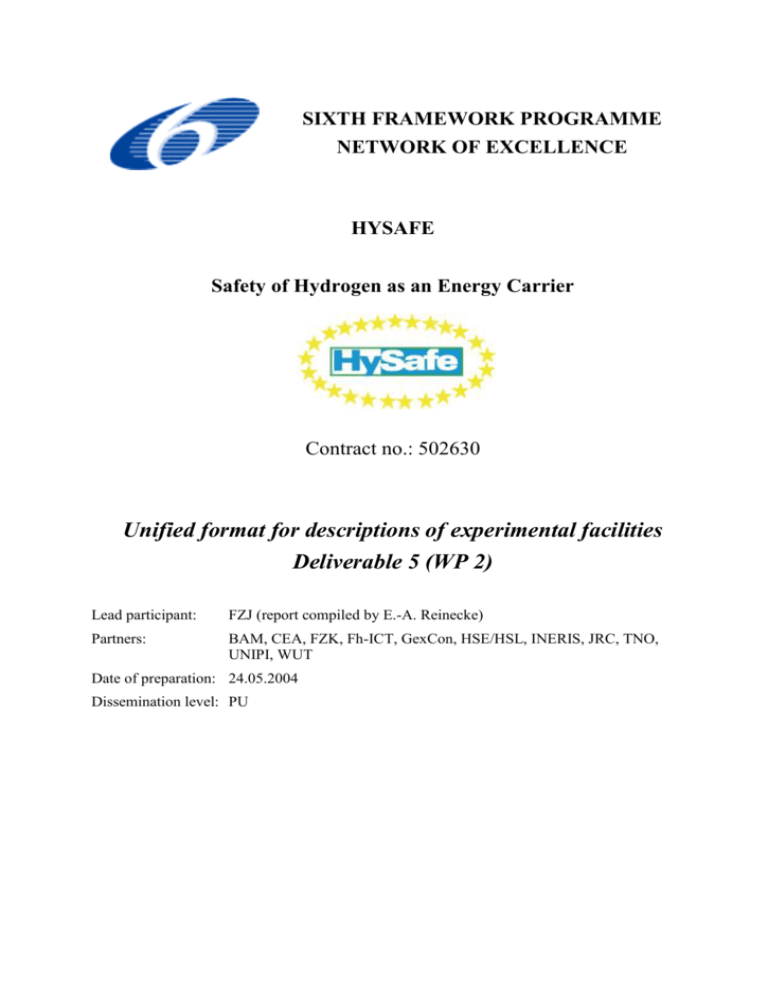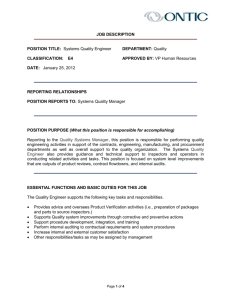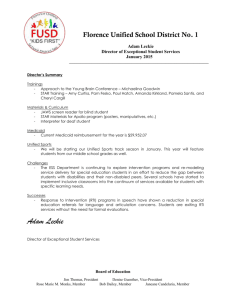D05 - HySafe - Safety of Hydrogen as an Energy Carrier
advertisement

SIXTH FRAMEWORK PROGRAMME NETWORK OF EXCELLENCE HYSAFE Safety of Hydrogen as an Energy Carrier Contract no.: 502630 Unified format for descriptions of experimental facilities Deliverable 5 (WP 2) Lead participant: FZJ (report compiled by E.-A. Reinecke) Partners: BAM, CEA, FZK, Fh-ICT, GexCon, HSE/HSL, INERIS, JRC, TNO, UNIPI, WUT Date of preparation: 24.05.2004 Dissemination level: PU HySafe – Safety of Hydrogen as an Energy Carrier SUMMARY The main goal of the activity Integration of Experimental Facilities (IEF) is the creation of a set of specialised research facilities for jointly define, rank and perform test series related to the thematic structure of the network. Preparing the progression into a set of complementary specialised research facilities the partners will provide unified detailed descriptions of the facilities available. These documents shall support identifying the best expertise of the partners identifying gaps and the need of further partners enabling the promotion of improvement of the experimental possibilities. The document in hand presents the format for the descriptions of the experimental facilities. The final facility descriptions will be published as deliverable (D9) and on the HySafe-Website. Unified format for descriptions 2/8 D05JRC HySafe – Safety of Hydrogen as an Energy Carrier D05 – Unified format for descriptions of experimental facilities CONTENTS D05 – Unified format for descriptions of experimental facilities ................................................... 3 1 Introduction ............................................................................................................................ 4 2 Unified format for the descriptions ........................................................................................ 5 3 Conclusion ............................................................................................................................. 8 Unified format for descriptions 3/8 D05JRC HySafe – Safety of Hydrogen as an Energy Carrier 1 Introduction Integration of Experimental Facilities (IEF) is one of the integrating activities within the network HySafe aiming at the integration of experience and knowledge on hydrogen safety in Europe as well as at the integration and harmonisation of the fragmented European research base. The creation of a set of specialised research facilities is the main goal of IEF. It will enable the network for jointly define, rank and perform test series in the application areas H2 production Transport and distribution, pipelines, refuelling stations Storing hydrogen (LH2, CGH2) Vehicles powered with H2 (passenger cars, trucks, repair shops) Tunnels, public parking and private garage Utilisation, portable or stationary H2 based applications on the issues Hydrogen release, mixing, and distribution Ignition properties, thermal, pressure, and missile effects from H2 fires and H2-air explosions Mitigation techniques (prevention of H2 release, detection, dilution, removal of hydrogen, and reduction of consequences from H2 fires and explosions). Research facilities are needed for the investigation of relevant phenomena, for testing devices and concepts as well as for validation of numerical models. The experimental data users within HySafe work in fields as e.g. code development, development of mitigation techniques, risk assessment analysis, or phenomena ranking. Consequently, a close co-operation especially between IEF and the vertical JRP is necessary. Figure 1 gives an overview of the connections between IEF and the other HySafe activities. Figure 1: Connections between IEF and the other HySafe activities Unified format for descriptions 4/8 D05JRC HySafe – Safety of Hydrogen as an Energy Carrier During the first 18 months, WP2 will prepare the basis for future integration of the experimental facilities. As a first step, the IEF partners will provide unified detailed descriptions of the facilities available for carrying out specific tests and experiments related to the thematic structure of the network. These descriptions will be the first step to a better knowledge of each other and will prepare the progression into a set of complementary specialised research facilities by identifying the best expertise of the partners identifying gaps and the need of further partners enabling the promotion of improvement of the experimental possibilities. 2 Unified format for the descriptions A first glance at the experimental possibilities of the IEF partners indicates potential overlappings e.g. in the field of hydrogen explosion, while other fields might be less represented (Fig. 2). Figure 2: IEF partners and experimental possibilities In order to provide a more detailed overview of the experimental possibilities of the partners, a unified format for the descriptions of the experimental facilities has been developed (Figs. 3 and 4). The document is divided into the sections Overview Technical details Experiments – Equipment Preparation of integration. The final section deals with information serving for the preparation of the integration activities Exchange of instruments and personnel Filling gaps Promotion and specialisation. The version in hand includes comments on the single points for clarification in italics. Unified format for descriptions 5/8 D05JRC HySafe – Safety of Hydrogen as an Energy Carrier Unified format of facility descriptions Overview Name Photograph Type e.g. vessel, flow reactor,... Scale e.g. lab scale, pilot scale, small scale, large scale, full scale... Experiments e.g. studies on vented explosions, tank testing, ... multiple entries possible Application field within the thematic structure of HySafe H1-H6, V1-V5 Technical details Dimensions e.g. m³ vessel, tube diameter,... Temperatures if appropriate Pressure if appropriate, e.g. for a vessel Media e.g. hydrogen, air, nitrogen, steam, ... Special features features that make the facility unique Further particulars if appropriate Figure 3: Unified format for facility descriptions, page 1 Unified format for descriptions 6/8 D05JRC HySafe – Safety of Hydrogen as an Energy Carrier Experiments – Equipment Experiments short technical description (some sentences) Level of detail Instrumentation e.g. gas temperature pressure gas composition velocity ... thermocouples piezoelectric mass spectrometer ... Schedule time needed for preparation, conduction, interpretation of experiments Tools e.g. software used for interpretation of results Further particulars if appropriate Information for the preparation of integration Exchange of instruments and personnel How many persons are needed to prepare/conduct experiments? What kind of movable equipment is available and could be shared? To prepare filling possible gaps What kind of experiments/tests could be performed in this facility after minor modifications and/or by applying additional instrumentation? To prepare promotion and specialisation What features/possibilities would you like to promote? What more/better results could you obtain if you had additional equipment? Figure 4: Unified format for facility descriptions, page 2 Unified format for descriptions 7/8 D05JRC HySafe – Safety of Hydrogen as an Energy Carrier 3 Conclusion The final descriptions of the experimental facilities will be prepared by all IEF partners. The compiled descriptions will be reported as deliverable (D9). These documents will also be available on the HySafe Website. Unified format for descriptions 8/8 D05JRC







